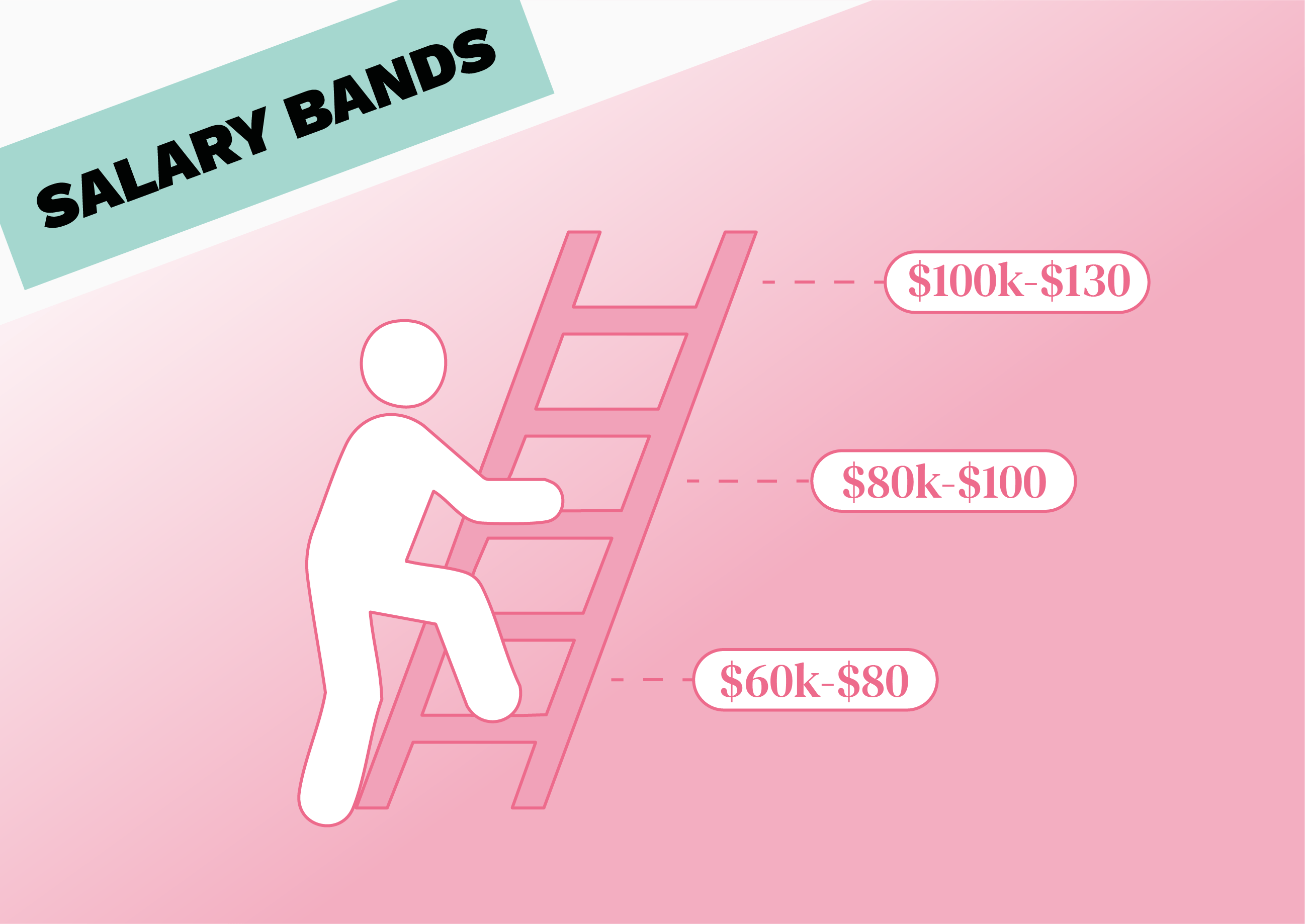If you’ve been keeping an eye on this blog, you’ll know we’ve recently been diving into all things salary bands.
We provided a comprehensive checklist to guide you through the process of creating your salary bands. We’ve discussed how to define a salary band for a brand new job within your organisation. And we’ve talked about what you should do if you find a salary band outlier (it happens to the best of us).
But there’s one question we haven’t yet answered: how many salary bands do you actually need?
The simple answer is: it depends. The perfect structure for your company might be a disaster to another business — and vice versa. In this article, we’ll explore three approaches to creating salary bands, plus our advice on choosing the right structure for your organisation.
How to decide on the right salary band structure
Here are a few of the things you should consider when deciding on the best salary band structure for your business:
- Size and complexity: Smaller businesses without too many employees may be able to manage with fewer salary bands. But large companies with lots of different roles and levels probably need more.
- Compensation philosophy: Your compensation philosophy provides a foundation for every pay decision within your organisation — which means it should be at the heart of your salary structure.
- Business objectives: Your core business goals can also provide guidance when structuring your salary bands. For example, if you want to develop innovative products, you’ll likely reward tech talent more generously than other employees. This will be reflected in how you build your salary bands.
The importance of effective job levelling
Before going further, it’s important to define the job levels that you have within your organisation, if you haven’t already done so. For example, at Figures, we use the following levels for individual contributors:
- Junior
- Intermediate
- Senior
- Staff
Even the simplest of salary band structures will include a different salary band for each level, so it’s important to understand what these look like at your organisation.
So, how many salary bands do you need?
There are many different ways you could organise your salary bands. The key is to divide up the roles in your organisation into logical, consistent categories. You can choose to be as broad or as granular as you like here. However, it’s important to remember that the more roles each salary band encompasses, the less useful it will be.
Below, we’ll discuss three different approaches to building your salary structure, from the simplest to the most complex.
Option #1: General salary bands for the entire company
The simplest way to organise your salary bands is to develop one consistent framework for the entire organisation, based purely on job levels. In this system, all junior employees will be paid within the same range, regardless of their actual role.
The problem with this approach is that it can result in very crowded salary bands, which can be difficult to use. Generally speaking, there is too much variance in market salaries across different roles and departments for this system to be very useful. To compensate for this, you’ll likely end up with extremely wide salary bands with a lot of overlap between them — which isn’t much better than no salary bands at all.
{{cta}}
Option #2: Salary bands grouped by department or job family
The next option is to group your employees by department or job family, and create salary ranges for the different levels within those groups. For example, you might have four different salary ranges (junior, intermediate, senior and staff) for each job family, which might include:
- Business ops
- Customer support
- Product and design
- Etc
This approach allows you to use compensation strategically to achieve certain objectives. For example, many companies pay tech talent at a higher rate relative to the market than other employees, simply because competition for this talent is fiercer.
However, there are also some downsides. Although this is a more complex structure than the first option, it can still result in salary bands that are crowded and hard to manage, especially in large companies.
Inevitably, it also means that certain roles will be grouped together despite being very different in terms of both scope and market value. Since you want to pay everyone competitively, this can result in a lot of salary band outliers, which ultimately undermines your salary band system.
Option #3: Salary bands for every job
The final option is to create a separate salary range for every role on your company’s job framework, at every level. For example, you might have a different salary range for:
- Junior software engineers
- Intermediate software engineers
- Senior software engineers
- Staff-level software engineers
This allows you to align each salary band with your desired market positioning for each role, based on your compensation philosophy. Overall, this makes for a fairer and more competitive compensation structure. It can also simplify hiring decisions and facilitate budget planning.
Of course, there is one big disadvantage to this approach: it means dealing with a lot of salary bands. Just creating this many salary bands can be a huge undertaking, and refining and updating them as part of your compensation review process each year will take a lot of work too. Keep reading to the end to find out how Figures can simplify this process for your team.
{{cta}}
What about future roles?
When you’re building your salary structure, you’ll need to decide whether to create salary bands for roles that don’t yet exist in your organisation, but which are likely to be introduced in the future.
Companies in hyper growth mode often have a very good idea of the new roles they’ll hire for in the near future. That means it often makes sense for them to save time later by pre-building salary bands for roles that don’t exist yet.
However, it’s much more common to create salary bands only for the roles you currently have, and build in new ones when the need arises. The important thing is to have a set process for defining a new salary band so you can ensure it’s aligned with your compensation philosophy and your overall salary structure.
{{cta}}
Should you account for location?
Many large organisations have offices in several different locations. And these days, even smaller companies may have employees working remotely from different cities or even different countries. If this is your situation, you’ll need to decide whether to consider each employee’s location when building your salary bands.
There are valid arguments to both sides here. Some people reason that employees living in high cost-of-living areas should get a higher salary, while others believe internal consistency is more important. In our view, neither approach is inherently unfair, as long as it’s applied consistently across the organisation.
If you do decide to account for location when building your salary bands, you have two options:
- Use the same salary band system for everyone, then apply a percentage adjustment based on the cost of living
- Develop separate salary bands for each location based on market data in each city/country
The first of these options is less administratively taxing. However, the second option provides more flexibility for large organisations who may need to account for significant differences in market salaries between different locations.
Building the right structure for your organisation
There’s no one right way to structure your salary bands. It all depends on what you’re trying to achieve through compensation, as laid out in your compensation philosophy. There may also be practical reasons for taking a certain approach: some companies simply don’t have the bandwidth to create individual salary bands for every role.
In our opinion, the best approach is to start relatively simple, and then iterate your salary bands as needed. For example, you might develop an initial set of salary bands based on departments or job families. This provides a good balance between keeping the structure simple and ensuring your pay is fair and competitive.
Then, you can begin to break out individual roles into their own salary bands as needed. For example, if benchmarking data shows that one role is typically paid much more than others within the same band, it may be a sign that it should be separated. Similarly, you might decide to create individual salary bands for roles that have different progression frameworks.
Your all-in-one tool for easy salary band creation
Want to know the secret to creating robust, custom salary bands? Figures. Using our platform, you can build a salary structure for your entire organisation in just a few minutes using data from your HRIS. You can then tweak and adjust your salary bands to make sure they meet your unique requirements.
You can also use Figures to access real-time salary benchmarking data, run smooth and effective compensation reviews — and much more. Want to find out how else Figures could help your organisation? Book a free demo to see it in action.
Summarize this article with AI
No time to read it all? Get a clear, structured, and actionable summary in one click.






